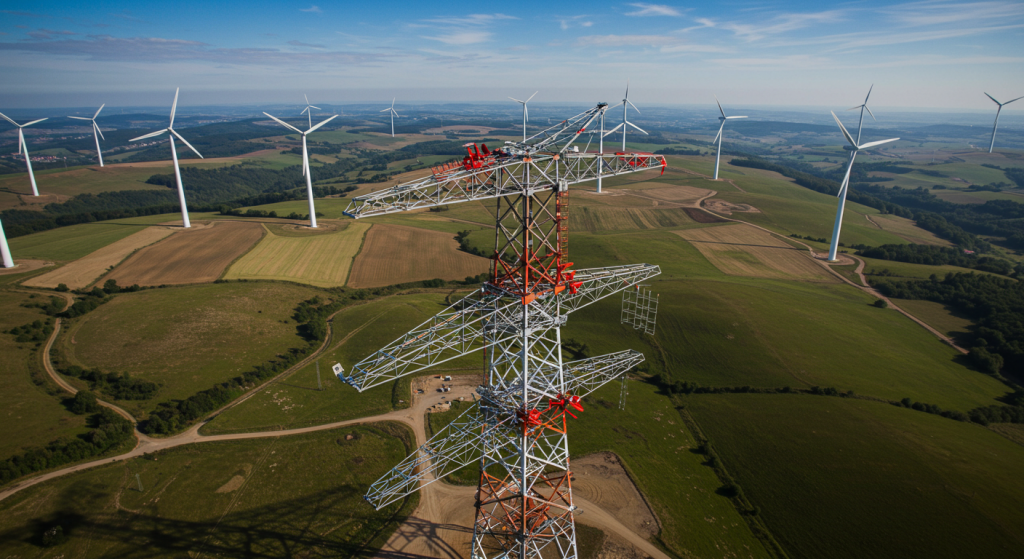Wind-Load Engineered Power Tower: Design & Benefits
2025-07-16
Why is Wind Load Important in Power Tower Construction
Wind is one of the environmental factors that can be the most harmful to tall structures. If proper consideration of architectural stress caused by wind is not made during construction, it may lead to some catastrophic damage. Wind-load engineered tower takes into consideration:
• The Impact of the Wind on The Structure of Towers
• Wind Forces from Bursts of Strong Winds
• Wind Spurts Effect and Turbulence
• Altitudinal limits of wind intensity and its region of origin
Basic Parts of Wind-Load Engineered Power Towers
1. Steel Lattice Power Tower Framework
The backbone of a wind-load engineered power tower is the steel lattice framework. Because of its gridded and open design, it causes less wind drag and pressure and can improve performance and reduce loads on the foundation. This framework improves the aerodynamic behaviour of the structure and provides efficient wind-load transfer.
2. Cross-Arm Shape
Cross-arms have a large importance for the safe simultaneous holding of several electrical conductors, and therefore, also for the vertical spacing. Cross-arms are designed to withstand a lot of lateral force, which is very useful in windy conditions. Ideal cross-arm designs maintain balance so there is no sway and withstand loads during storms.
3. Foundation Design
A good foundation secures the tower in place and prevents it from being lifted or toppled. Engineers check the soil and wind pressure to ascertain whether a deep or reinforced concrete foundation is needed. This part is critical for withstanding severe weather conditions for a long time.
4. Wind Damping Technologies
Wind can trigger oscillations on a tower, which can be dangerous and shorten its lifespan. To counter this, stock bridge and tuned mass dampers are types of vibration-damping systems that have been put in place to absorb oscillations. These systems are especially useful in windy areas, as they improve the endurance and safety of the structure.
Use Cases in Power Transmission Infrastructure
1. High-Voltage Overhead Power Lines
Wind-load engineered power towers are extensively used in high-voltage overhead transmission systems. These towers are designed to carry heavy loads of conductors at high altitudes, which exposes them to wind forces. Their durable construction guarantees energy will be available throughout each region regardless of the weather.
2. Smart Grid Transmission Systems
As the energy sector undergoes innovative transformations, these towers are crucial for enabling smart grid technology. Their environmental stress resilience enhances grid reliability and ensures constant communication between power stations, substations, and users. They assist in modernizing power systems to increase efficiency and real-time monitoring capabilities.
3. Coastal and Desert Areas with Strong Winds
Coastal and desert regions with strong winds require specially designed engineering structures. Wind-load optimized towers are constructed in these areas to withstand high winds and shifting soil. These towers also help improve stability and decrease the risk of collapse due to their aerodynamic design.
4. Strengthening Energy Infrastructure in Hurricane Zones
In storm-prone areas, infrastructure must withstand severe weather conditions. These towers protect power delivery during and post-natural disasters such as cyclones or hurricanes and extreme gusts. Use of these structures improves disaster preparedness and supports quick recovery efforts while bolstering resilience.

Wind-Load Engineered Power Towers Advantages
Increased Structural Resilience
Wind-load engineered power towers are built to endure severe weather like high-speed winds. Their aerodynamic designs, paired with robust frameworks, enhance structural resilience, lowering the risk of collapse or failure during storms or strong gusts.
Reduced Maintenance and Downtime
These towers are less prone to damage from the wind, which reduces maintenance. This is helpful because it lowers operational costs and downtime. As a result, this leads to improved energy transmission systems that have reduced interruptions.
Improved Public and Worker Safety
Due to these wind-resistant towers, there are lower risk factors for harsh environmental accidents for utility workers and citizens. Because of the structural rigidity, the towers will not allow for cascading failures, which raises the safety standards for the entire electric grid.
Longer Service Life in Extreme Environments
The construction of these wind-resistant towers is made with advanced engineering, which means they will sustain even in harsh coastal, desert, or high-altitude climates. These regions face demanding conditions; therefore, towers that do not succumb to fatigue and corrosion are ideal.
Compliance with Environmental Regulations
This is not only beneficial for avoiding legal barriers, but also encourages the construction of sustainable infrastructures. Following modern environmental and safety codes equips the towers with features that help maintain compliance with national and international regulations.
Wind-Load Protected Electric Towers
Due to climate change, hurricanes, cyclones, and high winds are growing in frequency and severity. To meet this problem, one of the future designs of the building’s infrastructure is to focus on wind-resistant transmission towers that provide greater power reliability. Besides catering to the smart grid systems that immensely help in the changing technology needs, these next-generation towers are capable of withstanding sharp winds.
- Moreover, modern techniques such as real-time structural health monitoring, adaptive damping systems, and sensor-triggered alert systems that identify concerning stress, vibration, or failure are integrated, allowing for to issuance of warnings beforehand.
- This approach dramatically increases the robustness of the grid infrastructure while maintaining the public’s safety and cutting down potential operational halts. Alongside adopting sustainable materials that meet green regulations, it improves the project’s overall concept.
- With high wind resistance, these towers strengthened with existing technology are bound to improve power grids for the future and greatly enhance the climate-survivability of the power transmission network.
Conclusion
Modern power transmission systems, wind-load engineered power tower, are essential with the increasing climate challenges as well as expanding energy demands. Like other structures, they possess reliable safety and longevity features such as aerodynamic steel lattice structures, smart cross arms, robust foundations, and advanced vibration-damping systems. These overcome obstacles in high voltage transmission lines, smart grids, and disaster-prone areas where infrastructural resilience is vital. Investing in these \engineered towers will result in supporting the world’s growing power needs while withstanding nature’s challenges.

Hey, I’m Chunjian Shu
"X.Y. Tower: Reliable, innovative solutions for high-quality towers and electrical equipment with professional service.
